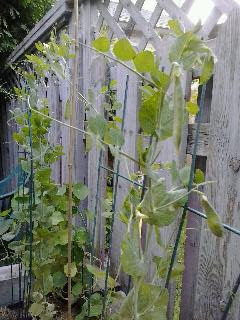It's been almost two months since my last garden update so as you can imagine there's been lots of changes. I certainly haven't been having a bumper vegetable crop but the few peas I have had are so sweet; the lettuce tasty; and the spinach disappointing but the tomatoes, carrots and squash are yet to come. I don't think the onion and garlic I planted from kitchen scraps have taken although the garlic was sprouting when I first planted it. I've learned so much and one thing I won't do again is companion plant nasturtiums. The variety I grew were huge and took over the bed but their multi-colored blooms are really pretty. I was prepared for the squash: it's outgrown the trellis I made and is now taking over the fence!

Psst scroll over each picture to read more about it.
My flower garden is still in progress. The zinnias grew to oversize and are blooming and the marigolds have just started. I had a rep from the city in for a consult about water-conserving and native plant gardens. So I've picked up a few perennials as they gone on sale which brings me to the Juncus.
I saw this gem of a plant with it's crazy curls and when I read the growing instructions which said it needs lots of water I thought "Perfect! I'll put it in the trouble spot where my neighbours eavetrough overflows and nothing else will grow there." When I got home I thought "But what about when it's not raining? It gets really dry there." That led me to the Internet of course and after combining mine and a few of others' ideas, I've come up with a really cute feature for the garden.
The juncus plant needs tons of water and is best planted in a constantly wet spot, or near (or even in a few inches of) water. It also spreads it's roots and starts shoots. I thought that maybe transplanting the juncus to a larger pot and burying the pot in the garden might hold some of the water. I drilled some large holes in a pot to allow some but not all of the roots to reach the bed. I dug a hole in the bed just deep enough for the pot to be about 2 inches above the surface. This was only for the aesthetic appeal.

As I was digging it started to rain and the hole began filling up. This tells me that once the rain reaches the clay-filled native soil it isn't draining well anyways. I still wanted to make sure the soil sta
yed wet enough so I came up with the idea to put a plastic plant drain tray underneath the pot. I hoping this way some of the water will pool.

If it doesn't seem like the plant is thriving and I want to check the drain tray, I can simply pull the pot from the ground, which hopefully will mean less disruption to the plant. I also made sure that the plant wasn't directly under the leaky eavetrough to prevent damage to the foliage during heavy rains.
Finally, I topped the soil in the pot with white stones and I think the end result is fantastic. Unfortunately, I lost too much daylight for my flashless cellphone to take a picture so I'll have to post the results plus the new perennials tomorrow!









No comments:
Post a Comment
To protect mine and my family's privacy, comments with identifying information will be edited. Comments will also be edited for obscenities.